Principality of Sancratosia
Principality of Sancratosia Prinsia de Sancratosia (Lingua Franca Nova) | |
|---|---|
| Motto: Monarcia bonvolente (Lingua Franca Nova) Benevolent monarchy | |
| Anthem: Imno nasional de Sancratosia National Anthem of Sancratosia | |
 General location of Sancratosia in North America | |
| Capital and largest municipality | Sancratosia |
| Official languages | Lingua Franca Nova |
| Recognised national languages | |
| Promoted languages[a] | |
| Demonym(s) | Sancratosian |
| Government | Unitary semi-constitutional monarchy |
| Princess Cloe | |
| Cristian Neuton | |
| Legislature | National Council |
| Sovereign state | |
• Declaration of independence | 1 December 2021 |
| Area | |
• Total | 574.20 km2 (221.70 sq mi) |
| Population | |
• 2023 estimate | 94 |
| Currency | Sancratosian impresa ( |
| Time zone | UTC−05:00 (Eastern Time Zone) |
• Summer (DST) | UTC-04:00 (Eastern Daylight Time) |
| Date format | |
| Driving side | right |
| Calling code | 761 (Proposed) |
| GUM 3-letter code | SNC |
| IMSO 1 code | SN |
| Internet TLD | .org |
Website sancratosia | |
Sancratosia (/sɑːn.kræ.toʊ.ʒə/ (![]() (listen)); Lingua Franca Nova pronunciation: /san.kra.to.sia/ (
(listen)); Lingua Franca Nova pronunciation: /san.kra.to.sia/ (![]() (listen))), officially the Principality of Sancratosia (Lingua Franca Nova: Prinsia de Sancratosia), is a self-proclaimed sovereign state operating within an extraterritorial territory located in North America. It is classified as a micronation by most external observers. The nation declared its independence on 1 December 2021.[1]
(listen))), officially the Principality of Sancratosia (Lingua Franca Nova: Prinsia de Sancratosia), is a self-proclaimed sovereign state operating within an extraterritorial territory located in North America. It is classified as a micronation by most external observers. The nation declared its independence on 1 December 2021.[1]
The official language of Sancratosia is Lingua Franca Nova, an auxiliary constructed language also known colloquially as Elefen. This makes Sancratosia one of the first nations to adopt the language as its official language. Despite Lingua Franca Nova's official status, French and English are more commonly used and spoken. These two languages are also recognized as national languages.
Sancratosia operates as a semi-constitutional monarchy where the sovereign personally exercises power in concert with other institutions. Unlike traditional monarchies, the monarch's power is derived from the people rather than from divine right.
Sancratosia is a member of several intermicronational organisations, including the MicroFrancophonie, the Grand Unified Micronational, the Conference of Santiago, the International Aerospace Community, and the Micronation Postal Association. The Principality was represented at MicroCon 2022 and MicroCon 2023 and will co-host MicroCon 2025. Sancratosia also co-hosts the annual Digi Micro Summit.
Etymology
- See also: Names of Sancratosia
Sancratosia's name is derived from the combination of two Greek words: "σαν" (san), meaning "like a; as a," and "κράτος" (kratos), meaning "state." The name reflects the aspiration to establish a nation considered equal to other nations. On 21 October 2021, the name was officially adopted, a date now celebrated as Emergence Day in Sancratosia.
History
Emergence of Sancratosia
Rise of micronational interest
In the early 2000s, Chloé Fortin Côté, the future leader of Sancratosia, developed an interest in the phenomenon of micronations, particularly the nations of Sealand and Molossia. This interest was rekindled many years later during the COVID-19 pandemic and the subsequent lockdowns, initially manifesting in the hobby of worldbuilding.
Brainstorming for an identity
In late October 2021, the Government of Quebec introduced new articles to Bill 2, An Act to reform family law with respect to filiation and to amend the Civil Code with respect to personality rights and civil status. These articles posed a threat to trans rights in the province. In response, Chloé conceived a protest against the bill and other actions taken by the Government since its election in 2018. Chloé decided that the creation of a micronation would be an ideal method for this protest, transforming a hobby of worldbuilding into the formal declaration of independence.
The brainstorming process for this micronation began on 16 October 2021. By 21 October 2021, the name "Sancratosia" was chosen, marking the Emergence of Sancratosia.
Initially, the envisioned government was a constitutional state, inspired by the constitutions of lusophone countries such as Cabo Verde and Mozambique. However, the extensive governmental structures of these larger states and the desire to maintain long-term control over the nation's direction led to reconsideration. Other historical constitutions, such as the Constitution of the July Monarchy and Portugal's Constitutional Charter of 1826, were also examined. Ultimately, Chloé found inspiration in the Constitution and culture of Monaco, which became the primary influences guiding the formation of Sancratosia.
Early development
Independence
On 24 November 2021, it was decided that the form of government for Sancratosia would be a principality, transitioning from the initially proposed constitutional state. Chloé Fortin Côté assumed the title of Sovereign Princess, adopting the regnal name Princess Cloe of Sancratosia, with the "H" omitted in alignment with Lingua Franca Nova.
After a week of drafting, the Declaration of independence was officially signed by Sovereign Princess Cloe, marking her first official act in office.
First year
Following the independence of Sancratosia, the nascent state faced the challenges of establishing a functional government. To address this, a Sovereign Ordinance granting temporary absolute power to the Sovereign Princess was promulgated on 2 December 2021.[2] This ordinance allowed the passage of laws in the absence of an elected National Council, primarily focusing on cultural elements such as national symbols and public holidays. Notably, it included the Law on the provisions against discrimination, a significant legislative measure for LGBT rights in Sancratosia.[3]
On 11 January 2022, Cristian Neuton was appointed as the first Minister of State of Sancratosia.[4]
The virtual representation of the Municipality of Sancratosia was launched on 5 February 2022 in the form of a Discord server. This initiative, suggested by Neuton, aimed to gather Sancratosians in one place for discussions on various topics, to keep foreign heads of state and diplomats informed about the Principality and for the establishment of virtual embassies.
The Sovereign Princess had her first official meeting with another micronational leader on 19 March 2022. Minister-President Dominic Desaintes of Saint-Castin met with Princess Cloe to discuss Quebec politics and other micronational topics.[5]
On 1 June 2022, to mark the six-month anniversary of Sancratosia, ePorteta was officially launched. This intranet portal, reserved for citizens, provided the Principality with a direct means of communication and a centralized platform for delivering services to its citizens.
One year anniversary
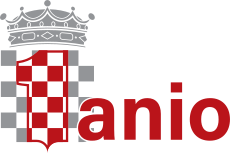
Celebrations for the one-year anniversary of Sancratosia commenced on 19 October 2022, as the Principality began its countdown to Emergence Day.[6] The festivities included the unveiling of the first permanent stamp series issued by Posta de Sancratosia, the inaugural State of the Principality of Sancratosia address, and the registration of the country's first private business.[7][8][9] Additionally, the Principality introduced a special anniversary logo, which also served as the basis for a commemorative stamp series.[10]
Francophone development
In early 2023, the Principality of Sancratosia initiated efforts to enhance its francophone presence, particularly in Quebec and within the international French-speaking community. As part of this initiative, the Principality formalized diplomatic relations with Saint-Castin and Aigues-Mortes, joined the regional Laurentian Micronational Cooperative Union, and was admitted to the Organisation de la MicroFrancophonie.[11][12][13]
Politics
Government
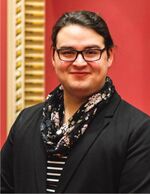
According to the Constitution, Sancratosia is governed as a constitutional monarchy, with the Sovereign Princess of Sancratosia serving as the head of state. executive power is exercised, in the name of the Sovereign, by the Minister of State, who acts as the head of government and presides over the Government Council.
The prerogative to propose and promulgate laws resides with the Sovereign Princess, while the National Council has the authority to modify and adopt these laws. This shared legislative power extends to any revisions of the Constitution.
Foreign relations

Sancratosia adheres to the declarative theory of statehood, which asserts that any entity possessing a defined territory, a permanent population, a functioning government, and the ability to engage with other micronational states is de facto recognized by Sancratosia. However, de jure recognition is withheld from states whose ideologies align with the far-right spectrum. The Ministry of Foreign Affairs maintains an official list of states that have received mutual recognition from Sancratosia.[14]
The Principality is a signatory to several conventions and agreements, including the Wrythe Convention, the Edgbaston Convention, the Augusta Accord and the Protocol of Klöw.
On 20 February 2022, Sancratosia became the second micronation surrounded by Canada to be admitted as a member of the Conference of Santiago. On 3 October 2022, it attained membership in the Grand Unified Micronational. Additionally, Sancratosia actively participates in the Francophone micronational community, holding membership in the Organisation de la MicroFrancophonie and the Laurentian Micronational Cooperative Union, a regional alliance with the Newgraviate of Saint-Castin and the Principality of Beremagne.
Princess Cloe represented Sancratosia at both MicroCon 2022 and MicroCon 2023, fostering informal diplomatic relations with numerous micronations including the Ambulatory Free States of Obsidia, the Royal Republic of Ladonia, the Kingdom of Ruritania, the Republic of West Who, the United Slabovian Empire, the Aerican Empire and the Republic of Molossia.
Geography

Sancratosia is situated in Northern America, completely surrounded by Canada within the province of Quebec. It is located on the Saint-Lawrence River and shares borders with the Montérégie region.
The principality is in close proximity to the Newgraviate of Saint-Castin and the Aerican Empire.
Time
The Principality of Sancratosia operates within the Eastern Time Zone. By law, the official time in Sancratosia aligns with that of its immediate neighbor, the Province of Quebec.
Climate
Sancratosia experiences a climate identical to the southern part of Quebec. It falls under the warm-summer humid continental climate category (Köppen climate classification: Dfb)
The government of Sancratosia obtains its climate data from official Canadian sources specific to the region of Salaberry-de-Valleyfield.
| Climate data for Sancratosia | |||||||||||||
|---|---|---|---|---|---|---|---|---|---|---|---|---|---|
| Month | Jan | Feb | Mar | Apr | May | Jun | Jul | Aug | Sep | Oct | Nov | Dec | Year |
| Average high °C (°F) | −5.4 (22.3) |
−3.2 (26.2) |
2.3 (36.1) |
11.2 (52.2) |
18.7 (65.7) |
23.8 (74.8) |
26.1 (79) |
25.3 (77.5) |
20.6 (69.1) |
12.8 (55) |
5.8 (42.4) |
−1.4 (29.5) |
11.4 (52.5) |
| Daily mean °C (°F) | −9.6 (14.7) |
−7.8 (18) |
−2.2 (28) |
6.3 (43.3) |
13.3 (55.9) |
18.7 (65.7) |
21.1 (70) |
20.2 (68.4) |
15.6 (60.1) |
8.6 (47.5) |
2.2 (36) |
−5.1 (22.8) |
6.8 (44.2) |
| Average low °C (°F) | −13.8 (7.2) |
−12.3 (9.9) |
−6.7 (19.9) |
1.3 (34.3) |
7.9 (46.2) |
13.5 (56.3) |
16.0 (60.8) |
15.1 (59.2) |
10.6 (51.1) |
4.3 (39.7) |
−1.4 (29.5) |
−8.8 (16.2) |
2.1 (35.8) |
| Average Precipitation mm (inches) | 74.8 (2.945) |
59.3 (2.335) |
61.9 (2.437) |
77.3 (3.043) |
82.9 (3.264) |
94.7 (3.728) |
97.6 (3.843) |
92.5 (3.642) |
82.6 (3.252) |
92.0 (3.622) |
85.7 (3.374) |
76.8 (3.024) |
978.0 (38.504) |
| Average Rainfall mm (inches) | 24.2 (0.953) |
19.9 (0.783) |
31.9 (1.256) |
70.3 (2.768) |
82.9 (3.264) |
97.4 (3.835) |
97.6 (3.843) |
92.5 (3.642) |
82.6 (3.252) |
90.6 (3.567) |
74.4 (2.929) |
33.1 (1.303) |
794.7 (31.287) |
| Average Snowfall cm (inches) | 50.6 (19.92) |
39.3 (15.47) |
30.1 (11.85) |
7.2 (2.83) |
0.0 (0) |
0.0 (0) |
0.0 (0) |
0.0 (0) |
0.0 (0) |
1.3 (0.51) |
11.3 (4.45) |
43.7 (17.2) |
183.5 (72.24) |
| Source: Environment Canada[15] | |||||||||||||
Territorial status
Sancratosia maintains two distinct territorial statuses: operational and symbolic.
In a symbolic gesture, Sancratosia has asserted a territorial claim in the Montérégie region spanning an area of 574.20 km (356.79 mi). This claim encompasses the entirety of the Beauharnois-Salaberry Regional County Municipality, an area historically associated with members of the House of Sancratosia. The Principality does not exercise control over this territory, and the claim was officially formalized on 1 December 2023.
For its operational activities, Sancratosia designates the location from which it operates as an extraterritorial territory, asserting its sovereignty. However, this extraterritorial status has not received official recognition from the government of Canada.
Administrative divisions
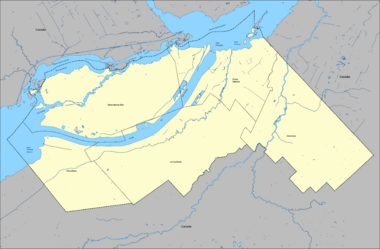
The Principality is administratively unified under a single municipality known as the municipality of Sancratosia. Geographically, there are no distinctions between the principality and the municipality; however, they differ in administrative competencies.
Municipal Districts
For administrative purposes, the municipality is currently subdivided into five districts:
- Altia Maria
- Costa Sabosa
- Jenoveva
- La Curiosia
- Sancratosia-Site
These districts serve to organize and manage local governance within the Principality of Sancratosia.
Economy
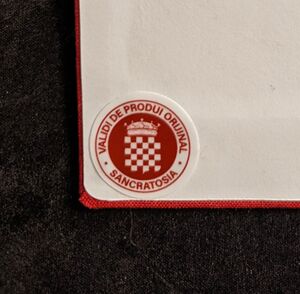
Sancratosia currently lacks a sustainable economy and relies entirely on the personal fortune of the House of Sancratosia for financial support. According to the Constitution, [[national budget allocations prioritize payments to the Sovereign Family before any other expenditures, resulting in all state revenues being directed to the Sovereign Family.
Taxes
Sancratosia applies a 25% value-added tax (VAT) on most goods and services, with prices typically displayed inclusive of VAT. There is no income tax imposed on citizens.
Currency
The official currency of Sancratosia is the Sancratosian impresa, commonly referred to as the Simpresa. Despite its official currency, transactions in Sancratosia also accept the Canadian dollar and the US dollar due to the close proximity to Canada and the United States.
Stamps
Posta de Sancratosia oversees the issuance of postage stamps within the Principality and plays a significant role in its economic and diplomatic activities. Revenue generated from stamp sales constitutes a primary income source for the Principality. While Sancratosia operates its own postal administration, it utilizes Canada Post for the delivery of mail.
Original product certification
Saluta Sancratosia manages the "Validi de produi orijinal de Sancratosia" program (English: Certification of original product from Sancratosia), which serves as a country of origin labelling initiative akin to "Made in..." labels. The program outlines guidelines for companies seeking certification for their products.
Saluta Sancratosia produces and distributes labels to certified companies, ensuring compliance through random inspections.
Population
Demographics
Sancratosians by status
As of 2021, Sancratosia had a population of 3 individuals, consisting predominantly of residents rather than nationals. The Principality introduced its naturalization process and citizenship program at the beginning of 2022, resulting in a rapid increase in population.[16] By 30 January 2022, less than a month after the program's launch, Sancratosia had expanded its citizenry to 10 individuals.[17]
Individuals holding citizenship in Sancratosia, whether nationals or residents, are collectively referred to as "Sancratosians".
Citizenship
The Principality of Sancratosia categorizes its citizens into two groups: nationals and residents. Sancratosian nationality is exclusive and cannot be held concurrently with citizenship from another nation; acquiring another nationality results in the forfeiture of Sancratosian citizenship.[b] Exceptions may be considered for individuals unable to renounce their original nationality.
Residency[c] status is open to all individuals, with certain restrictions on eligibility for political offices within Sancratosia.[18]
The acquisition and restoration of nationality fall under the authority of the Sovereign Princess.
Language
Lingua Franca Nova, colloquially known as Elefen, is designated as the official language of Sancratosia by the Constitution. Additionally, French and English are recognized as national languages.
Gestuno is a "promoted language" in Sancratosia. Previously, Quebec Sign Language served as the de facto official sign language due to the absence of a signed version of LFN.
Influenced by Sancratosia's connections with Brazilian micronations and the personal interest of the Sovereign Princess, Portuguese has also been declared a "promoted language" alongside Italian and Gestuno.
Religion
Sancratosia is a secular state, distinguishing itself from traditional monarchies by not deriving its authority from a divine source. The Principality operates as a modern secular monarchy, with the monarch's authority stemming from the people of Sancratosia. The Principality upholds freedom of religion as a fundamental right.
Public holidays
Public holidays[d] in Sancratosia are typically observed by taking the day off work. If a holiday falls on a weekend or no work is scheduled on the upcoming holiday, the day off is observed on the nearest business day.
List of public holidays
- 1 January: New Year's Day
- 15 January: George Boeree Day
- 10 February: National Flag Day
- Third Monday of February: Sancratosians' Day
- 1 March: Sovereign Princess Day
- 21 March: Elefen Language Day
- 15 April: Duchess Maria I Day
- 1 May: Workers' Day
- Fourth Friday of May: Friendship's Day
- 10 June: Chives Day
- First Monday of September: Goose Day
- 21 October: Emergence Day
- 11 November: Martlet Day
- 1 December: Independence Day
- 17 December: Maple Day
- 25 December: Winter's Day
Culture
The culture of Sancratosia reflects a blend of influences from Canadian, particularly Québécois, Monégasque, and French cultures, while also showcasing distinct characteristics shaped by the use of Lingua Franca Nova as its official language and its diverse population composed of naturalized individuals from around the globe.
National symbols

The Constitution of Sancratosia explicitly recognizes several national symbols, including the national flag, princely flag, and coat of arms. Additional symbols such as the national anthem are designated by legislation.
Flag
The national flag of Sancratosia features a quartered design of red and white, mirroring the pattern found on the Principality's coat of arms. In contrast, the princely flag displays a white field with the full coat of arms at its center. While the national flag is used in all official capacities, the princely flag is predominantly reserved for occasions involving Sancratosian dignitaries like the Sovereign Princess or the Minister of State.
Coat of arms
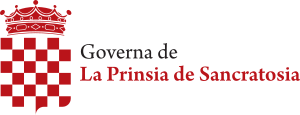
The coat of arms of Sancratosia serves as the principal symbol of the House of Sancratosia, the ruling dynasty. It enjoys widespread use across official documents and is prominently featured, in its smaller form, on the official signature of the government.
Sports
The official sport of Sancratosia is flying disc, although other sports such as football, cricket, and various forms of hockey (including floor, roller in-line and ice hockey) also enjoy popularity. The Sancratosian Sports and Games Confederation oversees local leagues, tournaments, and national teams.
Sancratosia participates in the Micronational Olympic Federation and is represented by its Micronational Olympic Committee. Additionally, the Principality engages in intermicronational fantasy leagues, with teams like AF Sancratosia representing the nation in competitions such as the MicroNations League Trophy.
Cuisine

Sancratosian cuisine is a fusion cuisine consisted mostly of Québécois, French and American culinary traditions. Staple dishes include poutine, soupe aux pois, pizza-ghetti, and sucre à la crème, the official dessert of the Principality.[19] Maple syrup features prominently in Sancratosian cuisine, particularly on dishes like crêpes.
Traditional meals are tied to national and public holidays, such as Goose Day, celebrated with dishes featuring small birds like foie gras or duck. Seasonal variations in cuisine are also observed, with richer meals enjoyed during the winter months.
The most popular beverages in Sancratosia are coffee and tea, reflecting their relative popularity among the populace.
Chez Chloé, a gastropub, holds the distinction of being the first registered company in Sancratosia, underscoring the significance of cuisine within the Principality.
Museums

Sancratosia boasts a network of public national museums administered by the National Museums of Sancratosia. Additionally, the Principality hosts several private museums dedicated to collections owned by the House of Sancratosia.
The Duchess Jana I National Museum and Archives houses artifacts related to Sancratosian history and the broader micronational community, including notable items like a 1994 Sealand Half-Dollar. It also safeguards the Crown Jewels and a signed copy of the Constitution.
The Duchess Maria II National Museum of Visual Arts features exhibitions showcasing visual art from Sancratosians and other micronationalists.
The Princely Museums Network coordinates private museums showcasing collections curated by the Sovereign Princess of Sancratosia. These include exhibits on the history of Canadian Airlines, the 1976 Summer Olympic Games in Montréal, the typewriter production by Brother Industries, the DeLorean Motor Company, and the art of worldbuilding.
See also
Notes and References
Notes
- ↑ Languages that are promoted by the government in certain capacity but have no Constitutional recognition.
- ↑ Sancratosian nationality is not mutually exclusive with that of macronational states.
- ↑ Physical residency is not a requirement to apply for Sancratosian residency.
- ↑ The preferred term in Sancratosia is "recreational days", considered to be more secular.
References
- ↑ Principality of Sancratosia, "The Principality of Sancratosia declares its independence", sancratosia.org
- ↑ Principality of Sancratosia (2 December 2021), "Sovereign Ordinance no 1 of 2 December 2021 on the temporary exercise of absolute power by the Sovereign Princess of Sancratosia", sancratosia.org
- ↑ Principality of Sancratosia (13 January 2022), "Law no 5 of 13 January 2022 on the provisions against discrimination", sancratosia.org
- ↑ Principality of Sancratosia (11 January 2022), "Sovereign Ordinance no 29 of 11 January 2022 on the nomination of the Minister of State", sancratosia.org
- ↑ Desaintes, Dominic (24 March 2022), "Le Ministre-president Desaintes rencontre la Princesse Cloe de Sancratosia.", L'Union de Saint-Castin
- ↑ Principality of Sancratosia (19 October 2022), "Countdown to Emergence Day.", Twitter
- ↑ Principality of Sancratosia (26 November 2022), "New permanent stamps! They will always remain valid even if mailing prices goes up.", Twitter
- ↑ Principality of Sancratosia (30 November 2022), "The Sovereign Princess gives her 2022 State of the Principality Speech", sancratosia.org
- ↑ Principality of Sancratosia. (2 December 2022), "Tonight, "Chez Chloé" will hold its opening night. This restaurant and bar is the first private business registered in Sancratosia", Twitter
- ↑ Principality of Sancratosia (1 December 2022), "New stamps for the one year anniversary of Sancratosia.", Twitter
- ↑ de Sancratosia, Cloe (12 March 2023), "Sancratosia joins the LMCU.", sancratosia.org, La Ganso Coronada
- ↑ de Sancratosia, Cloe (28 January 2023), "Official diplomatic relations between Sancratosia and Saint-Castin.", sancratosia.org, La Ganso Coronada
- ↑ de Sancratosia, Cloe (4 April 2023), "Three new members join the MicroFrancophonie.", sancratosia.org, La Ganso Coronada
- ↑ Principality of Sancratosia, "International recognition", sancratosia.org
- ↑ Government of Canada (31 October 2011), "Salaberry-de-Valleyfield Climate", Environment Canada
- ↑ Principality of Sancratosia (7 January 2022), "The Principality of Sancratosia unveils its citizenship program", sancratosia.org
- ↑ Principality of Sancratosia, "History of Sancratosia", sancratosia.org
- ↑ Principality of Sancratosia, "Citizenship", sancratosia.org
- ↑ Principality of Sancratosia (5 January 2022), "Law no 1 of 5 January 2022 on the national symbols", sancratosia.org
External links
- Pages including recorded pronunciations
- Micronations in Canada
- Monarchies
- Constitutional monarchies
- Principalities
- Democracies
- Micronations established in 2021
- Secular micronations
- Secessionist micronations
- Multilingual micronations
- Lingua Franca Nova-speaking regions
- French-speaking regions
- English-speaking regions
- Lingua Franca Nova-speaking micronations
- French-speaking micronations
- English-speaking micronations
- Grand Unified Micronational member states
- Member states of the Conference of Santiago
- Member states of the Constantia Pact
- Member states of the MicroFrancophonie
- DigiMicroSummit Attendees
- Sancratosia


